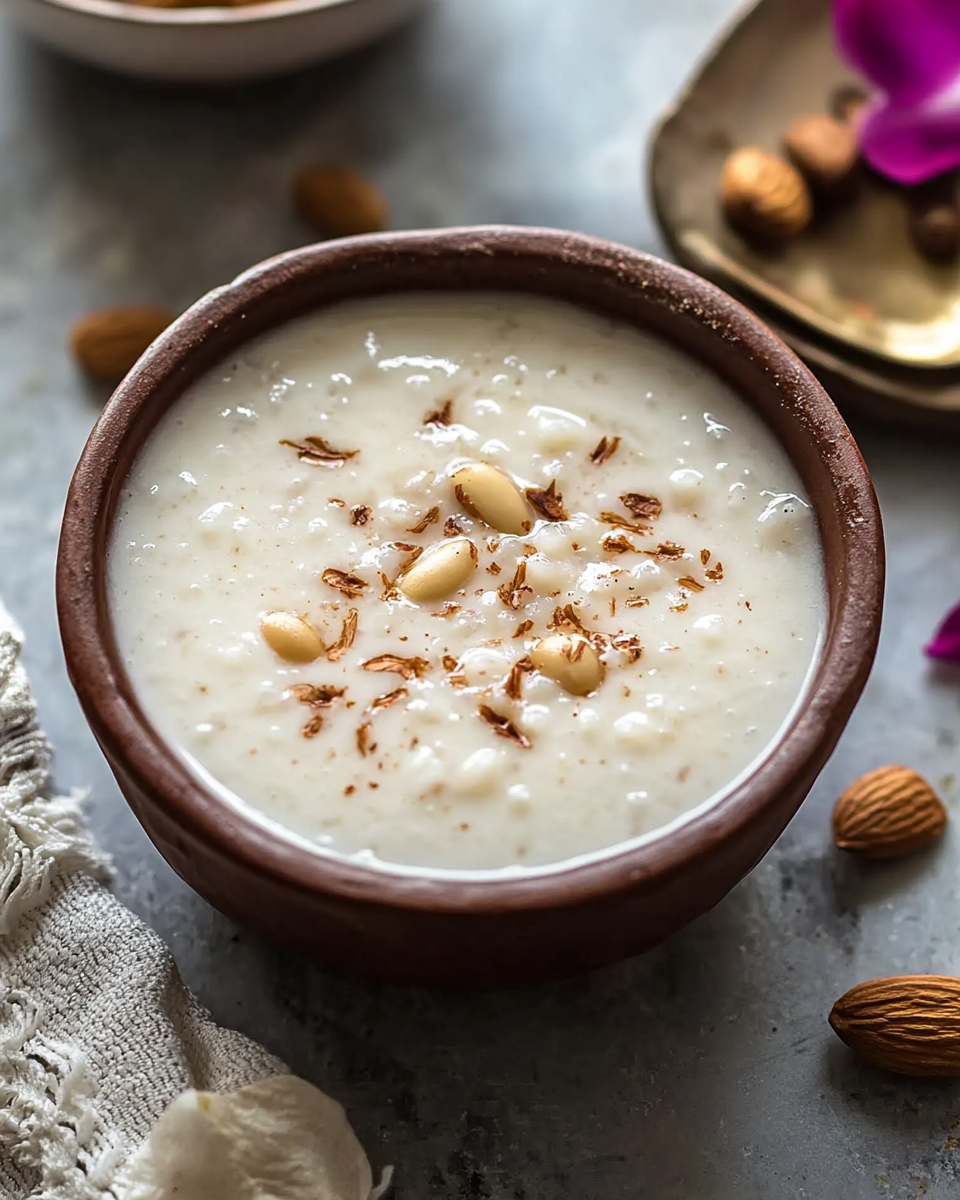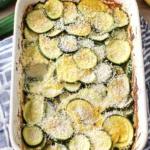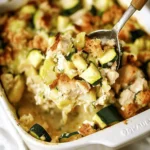A classic Indian dessert, Kheer is a creamy rice pudding made by simmering rice with milk and sugar, infused with cardamom, and enriched with nuts and dried fruits. This rich and aromatic treat is often served during festivals and special occasions, offering comfort in every spoonful.
FULL RECIPE
Ingredients
- 1/2 cup basmati rice
- 4 cups whole milk
- 1/2 cup sugar
- 1/4 teaspoon ground cardamom
- 2 tablespoons chopped almonds
- 2 tablespoons chopped cashews
- 1 tablespoon raisins
- 1 tablespoon ghee (clarified butter)
- A few strands of saffron (optional)
- 1/2 teaspoon rose water (optional)
Directions
- Rinse the basmati rice thoroughly and soak it in water for 30 minutes. Drain before use.
- Heat ghee in a heavy-bottomed pan. Add chopped almonds, cashews, and raisins. Sauté until golden and set aside.
- In the same pan, pour in the milk and bring it to a gentle boil.
- Add the soaked rice to the boiling milk. Reduce heat and simmer, stirring occasionally to avoid sticking.
- Continue to cook until the rice is soft and the milk thickens, about 30–40 minutes.
- Add sugar, cardamom powder, and saffron strands (if using). Stir well and cook for another 5–10 minutes.
- Stir in the sautéed nuts and raisins. Add rose water if desired.
- Serve warm or chilled, garnished with additional nuts.
Nutritional Information
- Calories: 280
- Protein: 6g
- Fat: 11g
- Carbohydrates: 38g
- Fiber: 1g
- Sugar: 18g
- Calcium: 15% DV
Cultural Significance of Kheer
Kheer is much more than just a dessert in Indian culture. It plays an important role in religious ceremonies, festivals, and family gatherings. The preparation of Kheer is an act of love and care, and it’s often offered to guests as a gesture of hospitality. It symbolizes prosperity, joy, and togetherness, making it an integral part of both special occasions and everyday celebrations.
Regional Variations
The beauty of Kheer lies in its versatility, with different regions of India offering unique twists on this classic dish. In South India, for example, the dessert is called Payasam and often made with jaggery and coconut milk, giving it a rich, earthy flavor. In Bengal, Kheer takes the form of Payesh, which is typically sweetened with date palm jaggery. The Maharashtrians have their own variation known as Kharwas, made with colostrum milk. Each version reflects the ingredients and tastes of the local culture, making Kheer a dish that transcends regional boundaries.
Historical Background
Kheer has deep historical roots in Indian culinary tradition. Dating back over 2,000 years, it was once an offering made in religious rituals, especially in temples. Ancient Ayurvedic texts also mention it as a nourishing food that promotes overall well-being. The dish’s simple yet rich ingredients made it popular with both the royal and common classes, and it has remained a beloved dessert for generations.
Texture and Flavor Profile
Kheer is known for its smooth, creamy texture and delicate flavor. The rice is cooked until tender, absorbing the rich flavors of milk and sugar. The cardamom and saffron impart a warm, aromatic depth to the dish, while the raisins provide bursts of sweetness. The addition of nuts like almonds and cashews adds a delightful crunch, giving the dish a wonderful contrast of textures that makes every bite interesting.
Serving Suggestions
Kheer is incredibly versatile when it comes to serving. You can enjoy it warm, at room temperature, or chilled. Many people prefer it chilled as the flavors tend to mature and develop more depth when it’s left to rest. It pairs wonderfully with other Indian dishes such as savory flatbreads like puri or even fried snacks. For a festive touch, you can garnish it with a sprinkle of crushed nuts or edible silver leaf, enhancing both its visual and taste appeal.
Occasions Best Suited for Kheer
Kheer is typically made during significant events such as Diwali, Eid, Raksha Bandhan, and Navratri. It’s also a popular dessert for birthdays, weddings, and other family gatherings. The dish’s sweetness and richness make it a perfect way to end a hearty meal, and its comforting nature makes it a great choice for any occasion that calls for celebration and togetherness.
Vegan and Lactose-Free Adaptations
For those who are lactose intolerant or follow a vegan lifestyle, Kheer can easily be adapted. Simply substitute regular milk with plant-based milk like almond, soy, or coconut milk. These dairy-free versions not only cater to dietary needs but also bring unique flavors to the dish, adding a new twist to a traditional recipe.
Health Benefits
Although Kheer is a sweet indulgence, it does come with some nutritional benefits. Milk, the main ingredient, is rich in calcium and protein, both of which are essential for bone health and overall body function. The nuts provide healthy fats and antioxidants, while the spices like cardamom help with digestion. When made with whole grains like brown rice, or even healthier alternatives like quinoa, Kheer can be a more wholesome dessert.
Customization Options
Kheer’s simple base allows for endless customization. You can experiment with different grains, like vermicelli or millet, to create new versions of the dish. Fresh fruits such as mango, banana, or berries can be added to give it a fresh, seasonal twist. For those who like bold flavors, additional spices like nutmeg or saffron can be used, creating a one-of-a-kind dessert tailored to individual tastes.
Storage Tips
Kheer can be stored in the refrigerator for up to three days. To maintain its creamy texture, store it in an airtight container. Over time, the rice may continue to absorb the liquid, so when ready to serve, stir the pudding and add a little milk to bring back its original consistency. Be sure to check for any signs of spoilage, especially if you’ve added fresh fruits or dairy alternatives.
Common Mistakes to Avoid
When making Kheer, it’s important to cook the rice properly so that it absorbs the milk and becomes tender. Avoid rushing the cooking process or using high heat, as this can cause the milk to curdle or scorch. Also, avoid adding sugar too early—wait until the rice has softened, as this ensures even sweetness throughout the pudding. Stirring regularly helps prevent the milk from sticking to the bottom of the pan.
Pairing with Other Dishes
Kheer is the perfect dessert to serve after a hearty Indian meal. It pairs wonderfully with spicy dishes such as biryani, samosas, or kebabs, offering a sweet contrast to the heat. In a traditional Indian thali, Kheer is often the last course, cleansing the palate and offering a satisfying finish to a meal.
Presentation Ideas
Kheer’s presentation can be as simple or as elaborate as you like. It can be served in rustic clay cups, traditional brass bowls, or modern glass cups. To make it look even more festive, you can garnish it with slivers of pistachios, rose petals, or a few strands of saffron. These little touches will enhance the visual appeal and make the dish feel even more special.
Popular Street and Festive Versions
Street vendors across India often serve Kheer in small clay cups called kulhads. This presentation adds an earthy aroma and is environmentally friendly, as the cups are biodegradable. During festivals, large batches of Kheer are often made in huge cauldrons and served to crowds of people, making it a communal, festive experience.
Symbolism and Spiritual Role
In many Indian households, Kheer is offered as a prasadam (sacred food) to the gods, especially during religious festivals. Its rich, comforting nature is thought to symbolize purity and devotion. It is also believed that serving Kheer to others can bring good luck and blessings, making it a dish that fosters a sense of spirituality and goodwill.
Inclusion in Ayurvedic Diets
Ayurveda, the ancient system of medicine, often considers Kheer a sattvic food, meaning it promotes calmness and clarity. Its ingredients, like milk and ghee, are considered nourishing and balancing. Cardamom and saffron are prized for their digestive properties and ability to uplift the mind, making Kheer a wholesome choice for anyone looking to promote balance in their diet.
Kheer in Literature and Folklore
Kheer is frequently mentioned in Indian literature and folklore. It is often described as the food of the gods or a reward for penance. Its presence in these ancient stories highlights its significance in Indian culture and spirituality, reinforcing its status as a revered and cherished dish.
Advertisement
Role in Indian Hospitality
In Indian culture, offering food to guests is an important tradition, and Kheer is often the centerpiece of such hospitality. Whether served during religious ceremonies or casual family gatherings, it is a dish that brings people together. By offering Kheer to guests, hosts convey respect and warmth, creating an atmosphere of generosity and care.
Influence on Modern Fusion Cuisine
In recent years, chefs have experimented with Kheer by adding contemporary flavors and ingredients. Chocolate, berries, or even coffee have found their way into this traditional dish, creating fusion variations that appeal to a broader audience. These modern adaptations maintain the essence of Kheer while introducing new flavors to global palates.
Conclusion
Kheer remains one of India’s most beloved desserts, appreciated for its rich history, versatility, and comforting qualities. Whether enjoyed in its traditional form or with modern variations, it continues to bring joy to people across cultures and generations. The simplicity of its ingredients combined with the warmth of its flavors makes Kheer not only a delicious treat but also a cherished part of Indian culture and hospitality. Whether served during festive occasions or everyday meals, it’s a dish that promises to evoke memories and create new ones with every bite.






